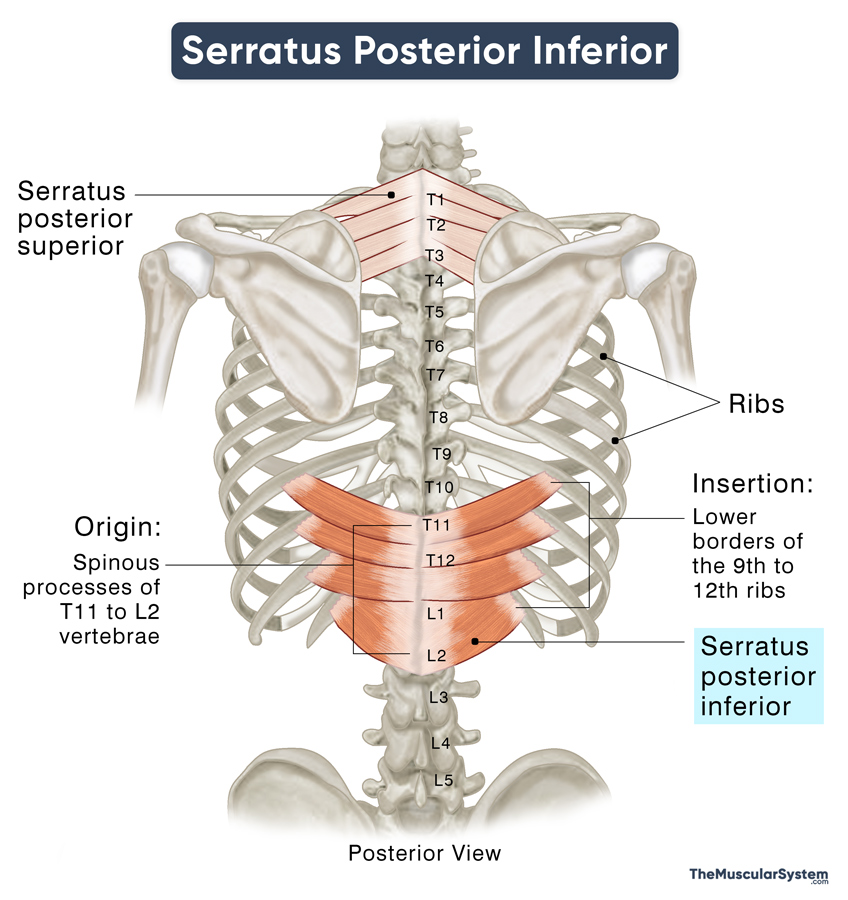Serratus Posterior Inferior
Last updated:
13/06/2024Della Barnes, an MS Anatomy graduate, blends medical research with accessible writing, simplifying complex anatomy for a better understanding and appreciation of human anatomy.
What is the Serratus Posterior Inferior
The serratus posterior inferior, or SPI, is a thin, broad, v-shaped, extrinsic muscle located in the lower back. It belongs to the intermediate layer of back muscles, with the serratus posterior superior being the only other muscle in the group. The muscle originates from the vertebral column and is inserted into the ribcage; hence, it is considered a chest muscle. The name comes from its characteristic serrated appearance. The muscle helps with moving the ribcage during respiration.
Anatomy
Serratus posterior inferior is located where the thoracic and lumbar regions of the spines meet.
Location and Attachments
| Origin | Spinous processes of T11 to L2 vertebrae |
| Insertion | Lower borders of the 9th to 12th ribs |
Origin
The muscle arises from the supraspinous ligaments and the spinous processes of the 11th thoracic vertebrae through the 2nd lumbar vertebrae (T11-L2).
Insertion
The muscle fibers then run laterally upward toward the ribs and insert into the lower back borders and outer surfaces of the 9th to 12th ribs. As the muscle fibers course toward their points of insertion, they maintain a relatively consistent thickness and divide into four distinct, flat, fleshy projections, each attaching to one of the ribs. The exact insertion point is slightly lateral to the costal angle of each rib.
Relations With Surrounding Muscles and Structures
The erector spinae muscles and the thoracolumbar fascia lie deep to the serratus posterior inferior, while it itself lies deep to the lower back muscle, latissimus dorsi.
The lateral branches of the thoracic spinal nerves from T7 to T12 pierce the muscle on their way down.
Function
| Action | Depressing the lower ribs to aid in exhalation |
Though there is some debate over the exact function of the muscle, it is known to help with respiration by pulling down the 9th to 12th ribs during expiration, especially in forced exhalation. This action reduces the volume of the thoracic cavity, which causes air to rush out of the lungs.
Research also suggests the muscle’s involvement in proprioception, the ability of the body to sense its own movements and position.
Innervation
| Nerve | T9 to T11 intercostal nerves and the subcostal nerve |
The muscle is innervated by the intercostal nerves T9 to T11, which originate from the anterior rami of the T9 to T11 thoracic spinal nerves. Additionally, the subcostal nerve running along the inferior border of the 12th rib also provides innervation to the serratus posterior inferior.
Blood Supply
| Artery | Subcostal artery and lumbar arteries |
Blood supply comes from the subcostal artery, the lowest (12th) posterior intercostal artery that runs along the lower border of the 12th rib. The first 2 lumbar arteries also contribute to the muscle’s vasculature.
References
- Serratus Posterior Inferior: TeachMeAnatomy.info
- Serratus Posterior Inferior Muscle: Elsevier.com
- Serratus Posterior Inferior Muscle: IMAIOS.com
- Serratus Posterior Inferior: HealthLine.com
- Serratus Posterior Muscles: Study.com
- Serratus Posterior Muscles: Anatomy, Clinical Relevance, And Function: PubMed.NCBI.NLM.NIH.gov
- Serratus Posterior Muscles: Kenhub.com
Della Barnes, an MS Anatomy graduate, blends medical research with accessible writing, simplifying complex anatomy for a better understanding and appreciation of human anatomy.
- Latest Posts by Della Barnes, MS Anatomy
-
Temporoparietalis
- -
Corrugator Supercilii
- -
Depressor Supercilii
- All Posts






